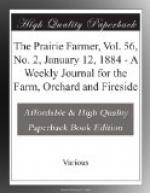----------
I give these as samples to guide my brother farmers in selecting names for their homes. Every one of those farms can be identified by some local peculiarity, prominent and visible. For instance, Davis place is situated close to a large pond covered with white lilies. Standing on the doorsteps of the Manning place you can view a ten-mile stretch of the Mississippi river, while Mr. Relley’s place is situated on the banks of that great stream. Such names can be multiplied to an indefinite extent, and duplicated in each county.
If such names were generally in use, it would greatly assist postmasters in their difficult task of knowing which Smith or Brown was intended.
Now brother farmers, I have moved the adoption of appropriate names for every farm in the land; who will second the motion? Give your wives and daughters a chance to name the homestead, and my word for it, it will be both musical and appropriate. Let us give our children something pleasant to think of after they have left the dear old home. To afix the name, paint it on a large board and nail it over your front gate.
Alex Ross,
Cape Girardeau,
Mo.
DIOGENES IN HIS TUB.
Allow me, Messrs. Editors, to give you notes of what I see, and hear, and learn, and cogitate, and endeavor to inculcate, from my snug little home in my Tub—will you not?
Well—having your assent, I begin by wishing you all—editors, correspondents, typos, and “devils”—a Happy New Year, and your excellent paper unlimited success in 1884, and a long life thereafter. Next, permit me to advert to the contents of some
Recent numbers.
First, to the pro and con of pasturing corn-stalks. That is a subject, like many others, on which much can be said on both sides. Mr. Stahl (in No. 50) quotes Prof. Sanborn as saying that a ton of corn fodder, “rightly cured and saved,” is worth two-thirds of a ton of good timothy hay. That may be true; but to be rightly cured and saved it must be protected from the rains and snows as the hay is; otherwise it will be as worthless as the corn left standing in the field. Most people who have cut their corn and left it standing in the shock during the fall rains, know by experience that large portions of it are rendered useless. And if we deduct the waste of corn by wet, and by rats and mice, and the waste of fodder, added to the cost of cutting, it would seem that a “Subscriber” (in No. 52) has at least a strong side of the argument. But these men are both right, in a degree. In the East in cases where the crop is not large, or in the West, and where the producer has large barns or sheds in which to store his fodder, it had doubtless best be cut and utilized in that way. But where no such facilities exist and the crop is large, as usual in the West, I can conceive of no better way to utilize the product than to feed it where it grew.




